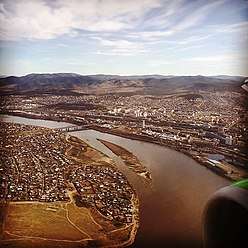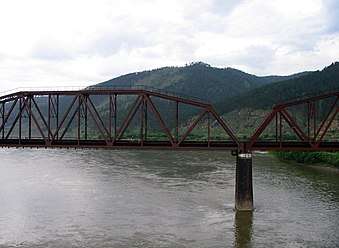Selenga
The Selenga or Selenge (/sɛlɛŋˈɡɑː/[1] Mongolian: Сэлэнгэ мөрөн, romanized: Selenge mörön; Buryat: Сэлэнгэ гол / Сэлэнгэ мүрэн, romanized: Selenge gol / Selenge müren; Russian: Селенга́, IPA: [sʲɪlʲɪnˈɡa]) is a major river in Mongolia and Buryatia, Russia. Originating from its headwater tributaries, the Ider and the Delger mörön, it flows for 992–1,024 kilometres (616–636 mi)[2][3][4] before draining into Lake Baikal. The Selenga therefore makes up the most distant headwaters of the Yenisey-Angara river system.
| Selenga Selenge | |
|---|---|
 Selenga River in Russia | |
 | |
| Native name | Селенга Сэлэнгэ |
| Location | |
| Country | Russia, Mongolia |
| Physical characteristics | |
| Source | Delgermörön |
| 2nd source | Ider |
| Source confluence | Olon golyn bilchir |
| • location | Khövsgöl, Mongolia |
| • coordinates | 49°15′40″N 100°40′45″E |
| Mouth | Lake Baikal |
| Length | 992 km (616 mi) |
| Basin size | 447,000 km2 (173,000 sq mi) |
| Discharge | |
| • location | Ust-Kyakhta |
| • average | 284 m3/s (10,000 cu ft/s) |
| • minimum | 23 m3/s (810 cu ft/s)February |
| • maximum | 601 m3/s (21,200 cu ft/s)August |
| Basin features | |
| Progression | Lake Baikal→ Angara→ Yenisey→ Kara Sea |
| Tributaries | |
| • right | Uda |
Carrying 935 cubic metres per second (33,000 cu ft/s) of water into Lake Baikal, it makes up almost half of the riverine inflow into the lake, and forms a wide delta of 680 square kilometres (260 sq mi) when it reaches the lake.
Name
The name Selenge comes from Mongolian seleh, which means "to swim". 'Selenga' is the russified version of the same.
An alternate source believes the name originated with the Evenki word sele ("iron") to which the nga suffix was added.[5]
The Selenge Province of Mongolia is named after the river.
 Automobile bridge over the Selenga River in the city of Ulan-Ude
Automobile bridge over the Selenga River in the city of Ulan-Ude Railway bridge over the Selenga River outside of Ulan Ude, Russia
Railway bridge over the Selenga River outside of Ulan Ude, Russia
Tributaries
The largest tributaries of the Selenga are, from source to mouth:
References
- "Selenga", Dictionary.com
- H. Barthel, Mongolei-Land zwischen Taiga und Wüste, Gotha 1990, p.34f
- "Сэлэнгэ мөрөн". www.medeelel.mn. Archived from the original on December 5, 2012. Retrieved July 16, 2007.
- "Селенга". Great Soviet Encyclopedia. www.yandex.ru. Retrieved May 5, 2009.
- E.M. Pospelov, Географические названия Мира (Geograficheskie nazvaniya mira, Moscow: Russkie slovari, 1998), p. 378.